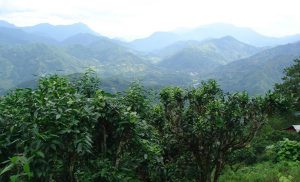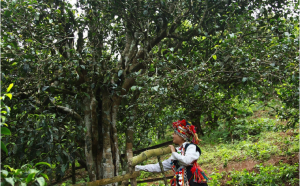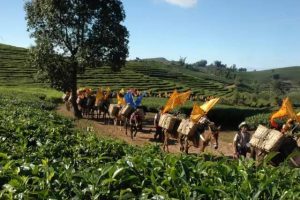Tea Culture Tour in Nan Nuo Mountain Tea Plantation
The Nannuo mountain is located in the eastern part of Menghai County, about an hour drive from Jinghong(approximately 30 km). It sits at an average altitude of 1,400 meters. Well known for its long history of tea growing, the mountain has gone through a series of transformations and remains a place for pilgrimage. Its trees, aged between 200-500 years old, produce some of the best puer tea. Being driven by a powerful incentive of traveling to see the groves of ancient tea trees, I’ve set my foot in Xishuangbanna, the heartland of puer tea production.

One morning, accompanied by an owner of a tea shop in Jinghong, we headed for a “stone village”, to meet some of the local tea farmers. Shitou village is a traditional Aini-Akha settlement, which peacefully rests on the side of Nannuo mountain, amid bamboo and tea groves.
Banana plantations, merging with the horizon, have given way to the rubber trees sitting straight in the rows across the hillsides. But the place we were about to explore bore not the slightest resemblance to what we’ve just seen. To find yourself in the wilderness of Xishuangbanna, you don’t need to cross hundreds of miles. A typical landscape is a rainforest with dense vegetation, where ancient tea trees feel at home. The serpent-like road, winding around the mountain, was once in a while flowing through the mystical tribal gates, decorated with sculls and pictographic inscriptions to scare away evil spirits. The Aini-Akha, indigenous people to inhabit the region for hundreds of years, is a populous ethnic group, which is spread across the south of Yunnan.
The name of the mountain comes from the Dai languageand is translated as “bamboo paste”, a dish made of fermented bamboo shoots. The Aini-Akha cuisine is diverse enough and worth exploring, and you can still find this on the menu. The story behind tells us about bamboo growing thick at the foot of the mountain, and cooked by the locals in many different ways. One winter a settlement on the side of the mountain was visited by a feudal lord, who was then offered a bowl of sour bamboo paste. As the story goes, he loved the taste so much that later on commanded the villagers to manufacture and pay him the tribute in this heavenly delicious appetizer.
Upon reaching the village, scattered across the scenic landscape of Nannuo mountain, we took a hike into a nearly impenetrable thicket of ancient tea trees, which covers a territory of approximately 15,000 mu.
The truth is that the image of an ancient tea tree, looming large in my imagination, was utterly different from what it turned out to be in reality. Not the size of the redwood trees, these humble giants can barely overgrow a human. However, the so-called “King of the Ancient Tea Trees”, which makes a famous tourist attraction, is aged at over 800 years old and estimated 14.7 meters high.
Unlike the conventional tea hedgeswhich make up an average plantation, tea trees in Nannuo are left to grow freely in their natural form, with minimum pruning to encourage new leaf growth. The tea trees are treated completely organically, which is easily seen with the naked eye: the leaves appear to be home to insects and parasitic plants, none of which would survive pesticides very well. The plants include the rare species of “crab’s claw”and Dendrobium, which serve as raw material for a number of medicines used in traditional Chinese medicine. You may as well find them present within some herbal teas.
Being cultivated in line with hundreds of years of local farming tradition, the average tree produces about three kilograms of tea leaves per year. At the same time, tea trees which make up a hedge style plantation, harvested regularly to maintain a “hedge” shape, would give several times as much as that. New growth is generally harvested every 20 days, the harvest season starting as early as April and lasting through the late November.
The number of harvests per year may vary from place to place, however when a tea tree is given more time to recover, there is a better chance of getting high quality product. Such ancient tea trees produce the tea that can attract a very high market price, which far exceeds the price of the average plantation tea. Being extremely valuable, they provide the major source of income for the locals.

The harvesting of tea in the region begins in the period of Three Kingdoms (220-280). Hundreds of years later the mountain became a house for Bulang minority people, who developed the cultivation technology. Later the harvesting tradition was taken over by Aini-Akha minority, which settles across the mountain until now.
Nowadays a famous region of tea production, back in the time of Qing dynasty plantations already covering the area of 15000 mu were giving more than 300 tons of tea leaves per year. The raw tea was then transported to the places like Menghai and Yiwu for the further processing. Much of the tea was later exported to the neighboring countries, at the same time being widely consumed domestically. By the time of the late Qing dynasty, and the early republic, due to the social and political unrest which has significantly weakened the country’s economy, the tea market became unstable and dependent. Tea production has gradually declined until its rebirth in the second half of the last century. Yet it was only thirty years from now when some Chinese tea experts advised removing the ancient tea trees of Nannuo mountain and replacing them with conventional tea hedges or rubber trees…

At the end of the day we were resting at the house of one of the local tea growers. At last we could slake our thirst with a nice cup of raw puer tea, a universally favorite beverage in the region. The Nannuo mountain has so much to say, and one more time it was heard.














